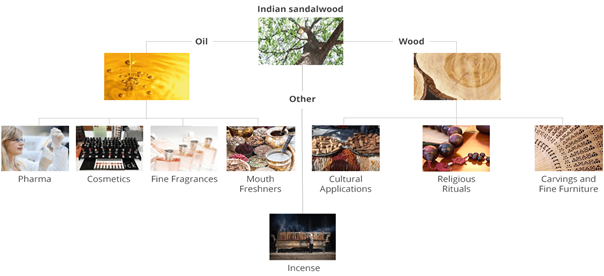

India’s sandalwood trees, the country’s pride — particularly of Karnataka — are facing a serious threat with the return of the destructive Sandalwood Spike Disease (SSD).
Context
India’s sandalwood trees, the country’s pride — particularly of Karnataka — are facing a serious threat with the return of the destructive Sandalwood Spike Disease (SSD).
About
What is Sandalwood Spike Disease?
- Sandalwood Spike Disease is an infectious disease caused by
- Phytoplasmas are bacterial parasites of plant tissues.
- They are transmitted by insect vectors and involved in plant-to-plant transmission.
- SSD has been one of the major causes for the decline in sandalwood production in the country for over a century.
- The disease was first reported in Kodagu in 1899.
- More than a million sandalwood trees were removed in the Kodagu and Mysuru region between 1903 and 1916.
- Later 98,734 trees were extracted during 1917-1925 in Salem also due to SSD.
- The devastating impact in natural habitats resulted in sandalwood being classified as “vulnerable” by the International Union for Conservation of Nature in 1998.
Is there any cure?
- There is no cure as of now for the infection.
- The infected tree will have to be cut down to prevent the spread of the disease.
Sandalwood distribution in India
In India, sandalwood is grown in around 9,000 sqkm, of which 8,200 sqkm is in Karnataka and Tamil Nadu
|
State (Area-sq km) |
Location |
|
Karnataka (5245) |
Districts of Shimoga, Chikkamagalur, Coorg, Hassan, Mysore, Chamarajnagar, Dharwad, Bangalore, Kolar, Belgaum, Uttara Kannada, Dakshina Kannada, Bellary and Tumkur |
|
Tamil Nadu (3040) |
Districts of Salem, Dharamapuri Erode, Tiruvannamalai, Vellore, the Nilgiris, Villupuram and to a certain extent in Madurai, Virudhunagar and Tirunelveli |
|
Kerala (15) |
Marayoor Range and to a limited extent in Arienkavu Range |
|
Andhra Pradesh (200) |
Anantapur, Chitoor and Kadapa, Tirumala Hills and Paderu Forest Division of Arakku valley |
|
Odisha (25) |
Jeypore and Rayagada forest divisions of Komput district |
|
Madhya Pradesh (33) |
Forests of Seoni, Sagar, Sehore, Mandsaur, Dewas, Guna and Rewa forest divisions |
|
Maharashtra (33) |
Ahmednagar, Latur, Buldana, Washim, Amravati, Osmanabad, Beed, Pune and Satara
|
|
Rajasthan (sparse) |
Udaipur, Rajsamand, Chittorgarh, Pratapgarh, Pali, Sirohi, Banswara, Dungarpur, Jhalawar, Ajmer and Karoli forest divisions |

- India has been the traditional leader of sandalwood oil production for perfumery and pharmaceuticals.
- As early as 1792, Tippu Sultan had declared it a ‘Royal Tree’ of Mysuru.
- The price of Indian sandalwood and its oil has risen significantly since 1995 at a rate of 20% annually mainly due to depletion in production.
- The much-loved and much-valued tree now faces a threat to its existence from SSD.


